Wenjie Li
Reasoning in the Dark: Interleaved Vision-Text Reasoning in Latent Space
Oct 14, 2025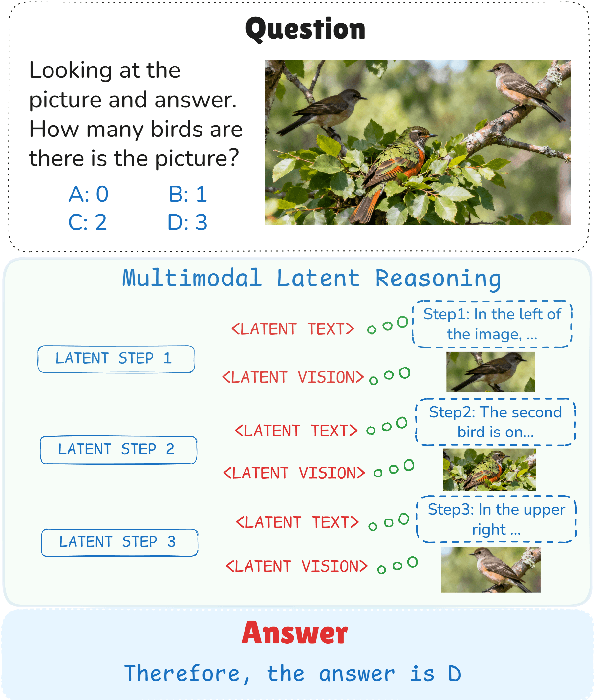
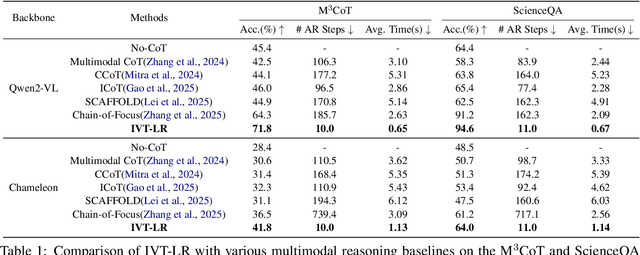
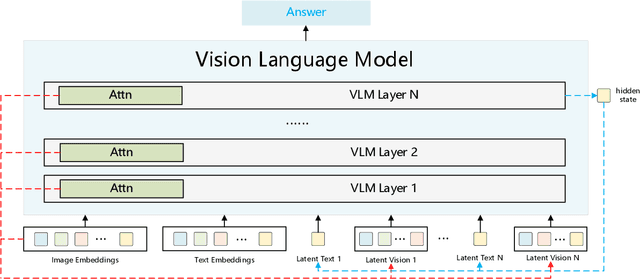

Abstract:Multimodal reasoning aims to enhance the capabilities of MLLMs by incorporating intermediate reasoning steps before reaching the final answer. It has evolved from text-only reasoning to the integration of visual information, enabling the thought process to be conveyed through both images and text. Despite its effectiveness, current multimodal reasoning methods depend on explicit reasoning steps that require labor-intensive vision-text annotations and inherently introduce significant inference latency. To address these issues, we introduce multimodal latent reasoning with the advantages of multimodal representation, reduced annotation, and inference efficiency. To facilicate it, we propose Interleaved Vision-Text Latent Reasoning (IVT-LR), which injects both visual and textual information in the reasoning process within the latent space. Specifically, IVT-LR represents each reasoning step by combining two implicit parts: latent text (the hidden states from the previous step) and latent vision (a set of selected image embeddings). We further introduce a progressive multi-stage training strategy to enable MLLMs to perform the above multimodal latent reasoning steps. Experiments on M3CoT and ScienceQA demonstrate that our IVT-LR method achieves an average performance increase of 5.45% in accuracy, while simultaneously achieving a speed increase of over 5 times compared to existing approaches. Code available at https://github.com/FYYDCC/IVT-LR.
Parallel Test-Time Scaling for Latent Reasoning Models
Oct 09, 2025Abstract:Parallel test-time scaling (TTS) is a pivotal approach for enhancing large language models (LLMs), typically by sampling multiple token-based chains-of-thought in parallel and aggregating outcomes through voting or search. Recent advances in latent reasoning, where intermediate reasoning unfolds in continuous vector spaces, offer a more efficient alternative to explicit Chain-of-Thought, yet whether such latent models can similarly benefit from parallel TTS remains open, mainly due to the absence of sampling mechanisms in continuous space, and the lack of probabilistic signals for advanced trajectory aggregation. \ This work enables parallel TTS for latent reasoning models by addressing the above issues. For sampling, we introduce two uncertainty-inspired stochastic strategies: Monte Carlo Dropout and Additive Gaussian Noise. For aggregation, we design a Latent Reward Model (LatentRM) trained with step-wise contrastive objective to score and guide latent reasoning. Extensive experiments and visualization analyses show that both sampling strategies scale effectively with compute and exhibit distinct exploration dynamics, while LatentRM enables effective trajectory selection. Together, our explorations open a new direction for scalable inference in continuous spaces. Code released at https://github.com/YRYangang/LatentTTS.
SpecGen: Neural Spectral BRDF Generation via Spectral-Spatial Tri-plane Aggregation
Aug 24, 2025Abstract:Synthesizing spectral images across different wavelengths is essential for photorealistic rendering. Unlike conventional spectral uplifting methods that convert RGB images into spectral ones, we introduce SpecGen, a novel method that generates spectral bidirectional reflectance distribution functions (BRDFs) from a single RGB image of a sphere. This enables spectral image rendering under arbitrary illuminations and shapes covered by the corresponding material. A key challenge in spectral BRDF generation is the scarcity of measured spectral BRDF data. To address this, we propose the Spectral-Spatial Tri-plane Aggregation (SSTA) network, which models reflectance responses across wavelengths and incident-outgoing directions, allowing the training strategy to leverage abundant RGB BRDF data to enhance spectral BRDF generation. Experiments show that our method accurately reconstructs spectral BRDFs from limited spectral data and surpasses state-of-the-art methods in hyperspectral image reconstruction, achieving an improvement of 8 dB in PSNR. Codes and data will be released upon acceptance.
Oblivionis: A Lightweight Learning and Unlearning Framework for Federated Large Language Models
Aug 12, 2025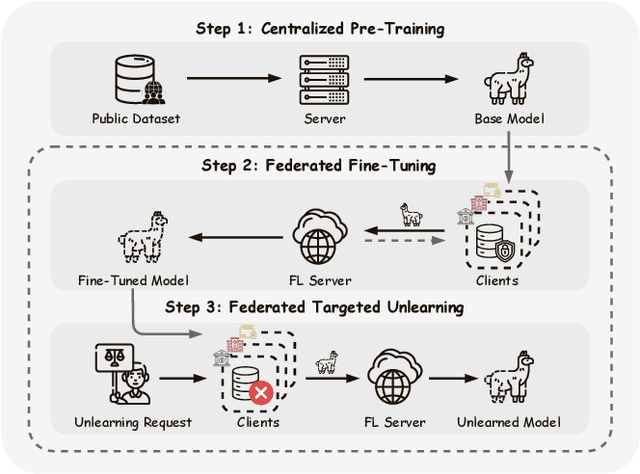

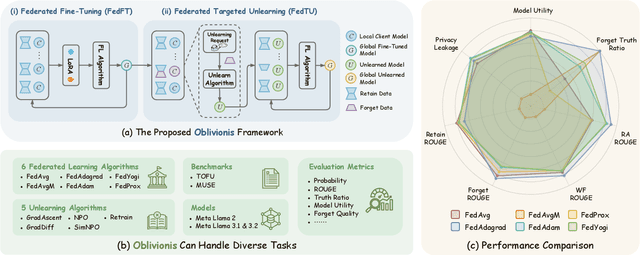
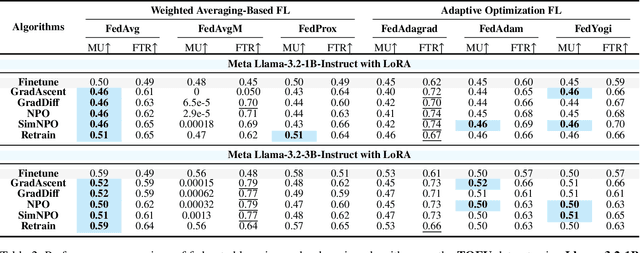
Abstract:Large Language Models (LLMs) increasingly leverage Federated Learning (FL) to utilize private, task-specific datasets for fine-tuning while preserving data privacy. However, while federated LLM frameworks effectively enable collaborative training without raw data sharing, they critically lack built-in mechanisms for regulatory compliance like GDPR's right to be forgotten. Integrating private data heightens concerns over data quality and long-term governance, yet existing distributed training frameworks offer no principled way to selectively remove specific client contributions post-training. Due to distributed data silos, stringent privacy constraints, and the intricacies of interdependent model aggregation, federated LLM unlearning is significantly more complex than centralized LLM unlearning. To address this gap, we introduce Oblivionis, a lightweight learning and unlearning framework that enables clients to selectively remove specific private data during federated LLM training, enhancing trustworthiness and regulatory compliance. By unifying FL and unlearning as a dual optimization objective, we incorporate 6 FL and 5 unlearning algorithms for comprehensive evaluation and comparative analysis, establishing a robust pipeline for federated LLM unlearning. Extensive experiments demonstrate that Oblivionis outperforms local training, achieving a robust balance between forgetting efficacy and model utility, with cross-algorithm comparisons providing clear directions for future LLM development.
DocRefine: An Intelligent Framework for Scientific Document Understanding and Content Optimization based on Multimodal Large Model Agents
Aug 09, 2025Abstract:The exponential growth of scientific literature in PDF format necessitates advanced tools for efficient and accurate document understanding, summarization, and content optimization. Traditional methods fall short in handling complex layouts and multimodal content, while direct application of Large Language Models (LLMs) and Vision-Language Large Models (LVLMs) lacks precision and control for intricate editing tasks. This paper introduces DocRefine, an innovative framework designed for intelligent understanding, content refinement, and automated summarization of scientific PDF documents, driven by natural language instructions. DocRefine leverages the power of advanced LVLMs (e.g., GPT-4o) by orchestrating a sophisticated multi-agent system comprising six specialized and collaborative agents: Layout & Structure Analysis, Multimodal Content Understanding, Instruction Decomposition, Content Refinement, Summarization & Generation, and Fidelity & Consistency Verification. This closed-loop feedback architecture ensures high semantic accuracy and visual fidelity. Evaluated on the comprehensive DocEditBench dataset, DocRefine consistently outperforms state-of-the-art baselines across various tasks, achieving overall scores of 86.7% for Semantic Consistency Score (SCS), 93.9% for Layout Fidelity Index (LFI), and 85.0% for Instruction Adherence Rate (IAR). These results demonstrate DocRefine's superior capability in handling complex multimodal document editing, preserving semantic integrity, and maintaining visual consistency, marking a significant advancement in automated scientific document processing.
Enhancing User Engagement in Socially-Driven Dialogue through Interactive LLM Alignments
Jun 26, 2025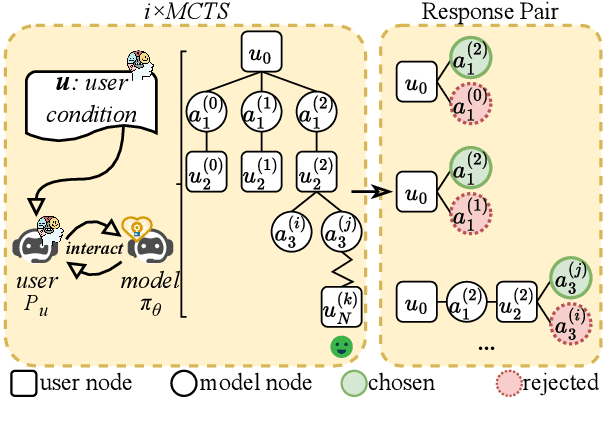
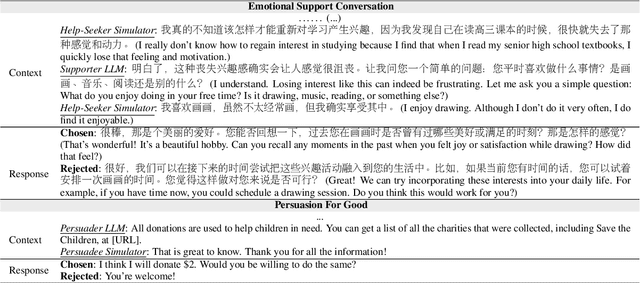
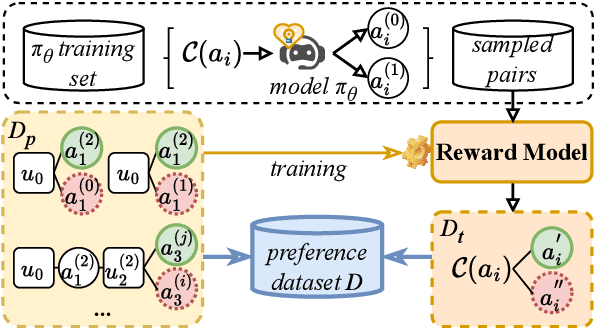

Abstract:Enhancing user engagement through interactions plays an essential role in socially-driven dialogues. While prior works have optimized models to reason over relevant knowledge or plan a dialogue act flow, the relationship between user engagement and knowledge or dialogue acts is subtle and does not guarantee user engagement in socially-driven dialogues. To this end, we enable interactive LLMs to learn user engagement by leveraging signals from the future development of conversations. Specifically, we adopt a more direct and relevant indicator of user engagement, i.e., the user's reaction related to dialogue intention after the interaction, as a reward to align interactive LLMs. To achieve this, we develop a user simulator to interact with target interactive LLMs and explore interactions between the user and the interactive LLM system via \textit{i$\times$MCTS} (\textit{M}onte \textit{C}arlo \textit{T}ree \textit{S}earch for \textit{i}nteraction). In this way, we collect a dataset containing pairs of higher and lower-quality experiences using \textit{i$\times$MCTS}, and align interactive LLMs for high-level user engagement by direct preference optimization (DPO) accordingly. Experiments conducted on two socially-driven dialogue scenarios (emotional support conversations and persuasion for good) demonstrate that our method effectively enhances user engagement in interactive LLMs.
FADPNet: Frequency-Aware Dual-Path Network for Face Super-Resolution
Jun 17, 2025Abstract:Face super-resolution (FSR) under limited computational costs remains an open problem. Existing approaches typically treat all facial pixels equally, resulting in suboptimal allocation of computational resources and degraded FSR performance. CNN is relatively sensitive to high-frequency facial features, such as component contours and facial outlines. Meanwhile, Mamba excels at capturing low-frequency features like facial color and fine-grained texture, and does so with lower complexity than Transformers. Motivated by these observations, we propose FADPNet, a Frequency-Aware Dual-Path Network that decomposes facial features into low- and high-frequency components and processes them via dedicated branches. For low-frequency regions, we introduce a Mamba-based Low-Frequency Enhancement Block (LFEB), which combines state-space attention with squeeze-and-excitation operations to extract low-frequency global interactions and emphasize informative channels. For high-frequency regions, we design a CNN-based Deep Position-Aware Attention (DPA) module to enhance spatially-dependent structural details, complemented by a lightweight High-Frequency Refinement (HFR) module that further refines frequency-specific representations. Through the above designs, our method achieves an excellent balance between FSR quality and model efficiency, outperforming existing approaches.
SPA-RL: Reinforcing LLM Agents via Stepwise Progress Attribution
May 27, 2025
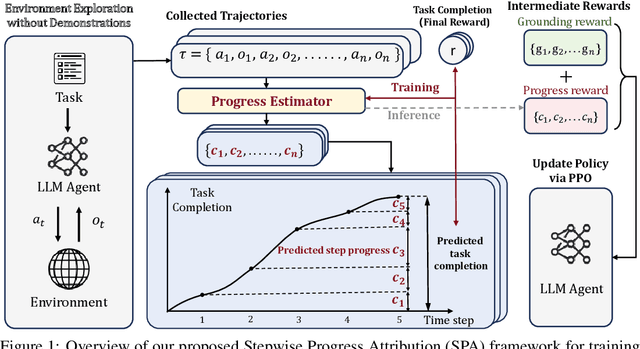


Abstract:Reinforcement learning (RL) holds significant promise for training LLM agents to handle complex, goal-oriented tasks that require multi-step interactions with external environments. However, a critical challenge when applying RL to these agentic tasks arises from delayed rewards: feedback signals are typically available only after the entire task is completed. This makes it non-trivial to assign delayed rewards to earlier actions, providing insufficient guidance regarding environmental constraints and hindering agent training. In this work, we draw on the insight that the ultimate completion of a task emerges from the cumulative progress an agent makes across individual steps. We propose Stepwise Progress Attribution (SPA), a general reward redistribution framework that decomposes the final reward into stepwise contributions, each reflecting its incremental progress toward overall task completion. To achieve this, we train a progress estimator that accumulates stepwise contributions over a trajectory to match the task completion. During policy optimization, we combine the estimated per-step contribution with a grounding signal for actions executed in the environment as the fine-grained, intermediate reward for effective agent training. Extensive experiments on common agent benchmarks (including Webshop, ALFWorld, and VirtualHome) demonstrate that SPA consistently outperforms the state-of-the-art method in both success rate (+2.5\% on average) and grounding accuracy (+1.9\% on average). Further analyses demonstrate that our method remarkably provides more effective intermediate rewards for RL training. Our code is available at https://github.com/WangHanLinHenry/SPA-RL-Agent.
Scaling over Scaling: Exploring Test-Time Scaling Pareto in Large Reasoning Models
May 26, 2025Abstract:Large reasoning models (LRMs) have exhibited the capacity of enhancing reasoning performance via internal test-time scaling. Building upon this, a promising direction is to further scale test-time compute to unlock even greater reasoning capabilities. However, as we push these scaling boundaries, systematically understanding the practical limits and achieving optimal resource allocation becomes a critical challenge. In this paper, we investigate the scaling Pareto of test-time scaling and introduce the Test-Time Scaling Performance Model (TTSPM). We theoretically analyze two fundamental paradigms for such extended scaling, parallel scaling and sequential scaling, from a probabilistic modeling perspective. Our primary contribution is the derivation of the saturation point on the scaling budget for both strategies, identifying thresholds beyond which additional computation yields diminishing returns. Remarkably, despite their distinct mechanisms, both paradigms converge to a unified mathematical structure in their upper bounds. We empirically validate our theoretical findings on challenging reasoning benchmarks, including AIME, MATH-500, and GPQA, demonstrating the practical utility of these bounds for test-time resource allocation. We hope that this work provides insights into the cost-benefit trade-offs of test-time scaling, guiding the development of more resource-efficient inference strategies for large reasoning models.
LIMOPro: Reasoning Refinement for Efficient and Effective Test-time Scaling
May 25, 2025Abstract:Large language models (LLMs) have demonstrated remarkable reasoning capabilities through test-time scaling approaches, particularly when fine-tuned with chain-of-thought (CoT) data distilled from more powerful large reasoning models (LRMs). However, these reasoning chains often contain verbose elements that mirror human problem-solving, categorized as progressive reasoning (the essential solution development path) and functional elements (verification processes, alternative solution approaches, and error corrections). While progressive reasoning is crucial, the functional elements significantly increase computational demands during test-time inference. We introduce PIR (Perplexity-based Importance Refinement), a principled framework that quantitatively evaluates the importance of each reasoning step based on its impact on answer prediction confidence. PIR systematically identifies and selectively prunes only low-importance functional steps while preserving progressive reasoning components, creating optimized training data that maintains the integrity of the core solution path while reducing verbosity. Models fine-tuned on PIR-optimized data exhibit superior test-time scaling properties, generating more concise reasoning chains while achieving improved accuracy (+0.9\% to +6.6\%) with significantly reduced token usage (-3\% to -41\%) across challenging reasoning benchmarks (AIME, AMC, and GPQA Diamond). Our approach demonstrates strong generalizability across different model sizes, data sources, and token budgets, offering a practical solution for deploying reasoning-capable LLMs in scenarios where efficient test-time scaling, response time, and computational efficiency are valuable constraints.
 Add to Chrome
Add to Chrome Add to Firefox
Add to Firefox Add to Edge
Add to Edge